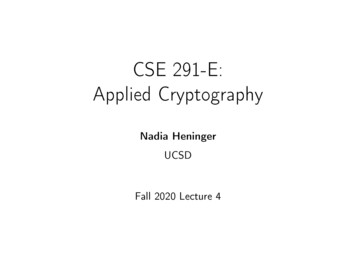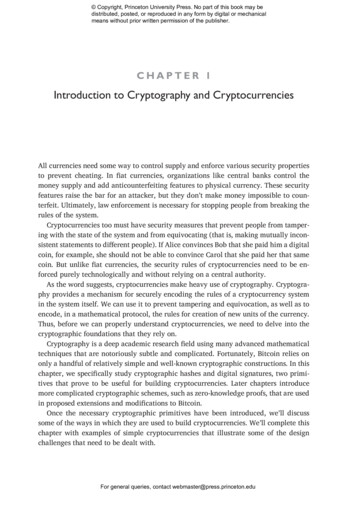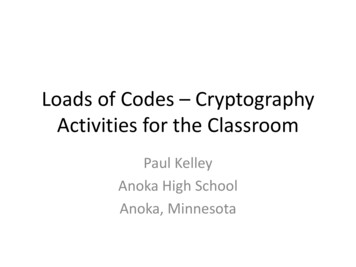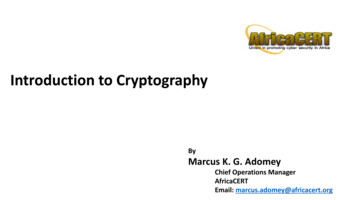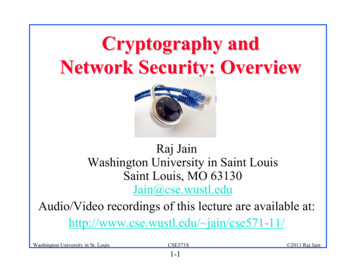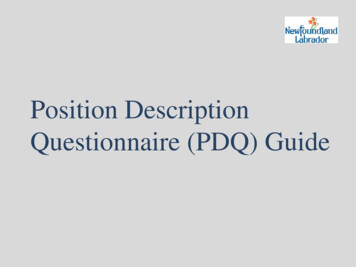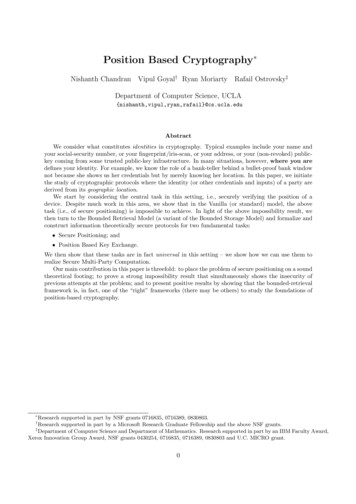
Transcription
Position Based Cryptography Nishanth Chandran Vipul Goyal† Ryan Moriarty Rafail Ostrovsky‡Department of Computer Science, ctWe consider what constitutes identities in cryptography. Typical examples include your name andyour social-security number, or your fingerprint/iris-scan, or your address, or your (non-revoked) publickey coming from some trusted public-key infrastructure. In many situations, however, where you aredefines your identity. For example, we know the role of a bank-teller behind a bullet-proof bank windownot because she shows us her credentials but by merely knowing her location. In this paper, we initiatethe study of cryptographic protocols where the identity (or other credentials and inputs) of a party arederived from its geographic location.We start by considering the central task in this setting, i.e., securely verifying the position of adevice. Despite much work in this area, we show that in the Vanilla (or standard) model, the abovetask (i.e., of secure positioning) is impossible to achieve. In light of the above impossibility result, wethen turn to the Bounded Retrieval Model (a variant of the Bounded Storage Model) and formalize andconstruct information theoretically secure protocols for two fundamental tasks: Secure Positioning; and Position Based Key Exchange.We then show that these tasks are in fact universal in this setting – we show how we can use them torealize Secure Multi-Party Computation.Our main contribution in this paper is threefold: to place the problem of secure positioning on a soundtheoretical footing; to prove a strong impossibility result that simultaneously shows the insecurity ofprevious attempts at the problem; and to present positive results by showing that the bounded-retrievalframework is, in fact, one of the “right” frameworks (there may be others) to study the foundations ofposition-based cryptography. Research supported in part by NSF grants 0716835, 0716389, 0830803.Research supported in part by a Microsoft Research Graduate Fellowship and the above NSF grants.‡Department of Computer Science and Department of Mathematics. Research supported in part by an IBM Faculty Award,Xerox Innovation Group Award, NSF grants 0430254, 0716835, 0716389, 0830803 and U.C. MICRO grant.†0
11.1IntroductionMotivationIn cryptography, typically a party will possess a set of credentials determining: its identity, what tasks it cando, which protocols it can participate in and so on. These set of credentials will typically correspond to theparty having some of the following attributes: some secret information (e.g., a secret key), authenticatedinformation (e.g., a digitally signed certificate from a trusted entity), biometric feature and so on. In thispaper, we ask the following question: can the geographical position of a party be one of the credentials?The geographical position of a party is valuable in a number of natural settings. We give a few examples: Position based Secret Communication. Consider communication between different military establishments. For example, the Pentagon in Washington D.C. might want to send a message (having someclassified information) such that it can only be read by an individual present at the US military base inSouth Korea. In a traditional solution, the South Korean military base will have a secret key to decryptthe message. However, the enemy might try to break into the military base computers to capture thiskey. It would be desirable to add an additional layer of security that would guarantee that anyonereading the message is physically present at the South Korean base. Position based Authentication/Signatures. In the above example, suppose the South Koreanmilitary base wants to send some information to the Pentagon. It would be desirable for the Pentagonto have a guarantee that the message was indeed sent from the geographical position of the militarybase.Indeed, the above list is not exhaustive. One could think about position based access control (whereaccess to a resource needs to be restricted to certain locations, e.g., a printer or fax machine is accessibleonly to people inside some set of offices) and pizza delivery (where the pizza company first wants to verifythat the person placing the order is indeed located at the delivery address he specified). To perform such“position specific” tasks, we introduce the notion of position based cryptography.The first natural question that arises is: “Can you convince others about where you are?”. Moreprecisely, we have a prover who claims be at a geographical position P . There is a set of remote verifiers(or in other words, a positioning infrastructure) who wish to make sure that the prover is indeed atposition P as claimed (for example, by executing a protocol with that prover). We call the above problemas “Secure Positioning”. The question of secure positioning is a fundamental one and deals with designinga system which enables a prover to communicate back and forth with a group of verifiers to give them aninteractive proof of its geographic position.The problem of secure positioning is well studied in the security community (see e.g., [SSW03, SP05,Bus04, CH05, CCS06]). The de-facto method to perform secure positioning is based on the time of responsetechnique where the messages travel with the speed of radio waves which is equal to the speed of light(this is similar in nature to how the commercial GPS systems work, see section 1.4). At a high level, theverifiers will send messages to the device and will measure the time taken to receive a response. Althoughthere have been several proposed protocols for secure positioning, all of them are completely insecure underthe so called “collusion attack”. That is, if a set of (possibly cloned) provers collude together and work ina controlled manner during the protocol execution, the provers will be able to convince the verifiers thatthe verifiers are talking to a prover at position P (even though none of the adversarial provers may beat P ). We in fact show that, unfortunately, such an attack is unavoidable. That is, it is impossible tohave secure protocols for positioning in this Vanilla model (even if one is willing to make computationalassumptions). Hence, we cannot hope to realize most of the meaningful position based tasks.In light of the above drawbacks, in this paper we explore the intriguing possibility if secure positioningprotocols exist which can resist collusion attacks. In search of an answer to this question, we turn to thebounded retrieval model (BRM), which is a variant of the bounded storage model (BSM) introduced byMaurer [Mau92]. Quite surprisingly, this model turns out to be a right model for proving the security1
of position-based cryptographic tasks. We first construct a protocol for information theoretic securepositioning in this model. To our knowledge, this is the first protocol which is secure even against collusionattacks. Although secure positioning is an important step, the full power of position based cryptographycan only be realized if we achieve key exchange with the device at a particular geographic position. Hencewe introduce position based key exchange and present two protocols to achieve it in the BRM. Our firstprotocol achieves security against a computationally bounded adversary (in the BRM). In this protocol,we achieve key exchange between the verifiers and any device at position P that is enclosed within thetetrahedron formed between 4 verifiers in 3-dimensional space. Our second protocol achieves informationtheoretic key exchange between the verifiers and devices at positions P that lie in a specific geometricregion (characterized by a condition that P must satisfy) within the tetrahedron.Note that we are interested only in verifying the position claim of devices that are within the tetrahedronenclosed between the 4 verifiers. This is not a limitation, since apriori, we are restricting, by geographicalbounds, the locations where an honest device can be located (such as inside a room, to get access to aprinter or a hard drive). If a device makes a position claim that lies outside of this region, we rejectthe claim without any verification. We stress, however, that we do not make any assumption about thepositions of adversaries in the system. In particular, this freedom for the adversarial devices guaranteesthat no set of adversaries (some of whom may even be outside of the tetrahedron) can falsely prove thatany one of them is at position P inside the tetrahedron as long as none of them are at position P .1.2The Two Models ConsideredThe Vanilla Model. We now informally describe the Vanilla model. We have a device (also referredto as the prover) who is located at a position P (where P is a point in a d-dimensional Euclidean space).There exists a set of verifiers {V1 , V2 , ., Vm } at different points in the d-dimensional space, such that Plies inside the tetrahedron enclosed by the verifiers. The verifiers are allowed to execute a protocol with theprover to achieve some task. More precisely, a verifier can send messages to the prover at different pointsin time (with a speed up to the speed of radio waves) and also record the messages which are received fromit (along with the time when they are received). The verifiers have a secret channel among themselvesusing which they can coordinate their actions by communicating before, during or after protocol execution.There could be multiple adversaries with possibly cloned devices who share a covert channel and colludetogether. This setting is referred to as the Vanilla model.The Bounded Retrieval Model. The bounded storage model (BSM) was introduced by Maurer in[Mau92] and has been the subject of much work [Mau92, CM97, CCM98, AR99, Din01, ADR02, DR02,Lu04, Vad04, MSTS04, DHRS04, DM04a, DM04b, Din05]. Very roughly, this model assumes that thereis a bound on the amount of information that parties (including an adversary) can store. It assumesthe existence of random strings, having high min-entropy, available to the parties at some point in theprotocol. An adversary is allowed to store an arbitrary function of these strings, as long as the lengthof the output of the function is not longer than the adversary’s storage bound. A closely related modelto the BSM is the bounded retrieval model (BRM), introduced and studied in various related contextsby Di Crescenzo et al. [CLW06] and Dziembowski [Dzi06a, Dzi06b]. This model assumes that partiescan store information having high min-entropy, but an adversary can only retrieve part of it. Recently,Dziembowski and Pietrzak [DP07] introduced intrusion resilient secret sharing where shares of a secret(stored on different machines) are made artificially large so that it is hard for an adversary to retrieve ashare completely, even if it breaks into the storage machine. We note that in the current work, we buildon the techniques of [DP07]. We extend these techniques and combine them with geometric arguments toprove the security of our protocols.In the context of position based cryptography, by bounded retrieval model, we mean the Vanilla modelsetting where the verifiers can broadcast information having high entropy (or control a randomness sourcewhich can) such that the adversaries can only retrieve, say, a constant fraction of this information as it2
passes by at high speed. The assumption that the adversaries cannot retrieve all the information thatgoes by seems very plausible in our setting since the information travels at a very high speed (particularlywhen, e.g., the verifiers have several sources broadcasting information at different frequencies).We note that our assumption, in some sense, is actually weaker than what is typically assumed whileworking in the bounded retrieval model. Unlike in BRM, we do not need to assume that honest partiesthemselves can store the strings that are being broadcast.1.3Our ContributionsIn this paper, we give the following results towards developing a theory of position based cryptography: We begin with a lower bound for the Vanilla model in Section 3. We show that there does not exist aprotocol in the Vanilla model using which a group of verifiers can securely verify the location claim of aprover. The impossibility is obtained via an explicit attack which does not depend on the computationalpower of the parties. To begin with, the lower bound holds if all the parties (i.e., the verifiers, the honestprover and the adversaries) are given unbounded computational power. Further, it holds even if theverifiers are given unbounded computational power but the adversaries (and thus the honest prover)are restricted to being probabilistic polynomial time (PPT) machines (i.e., one may make cryptographichardness assumptions). With the impossibility of this most fundamental task, we cannot hope to performmost other meaningful position based tasks (including position based key exchange) in the Vanilla model.Capkun et al. [CCS06] propose a protocol in which they assume that the geographical position of theprovers can either be “hidden” (not known to the adversary) or that the provers can move rapidly ingeographical space. Given the above severe lower bound, the task of now choosing a model in which protocols for securepositioning exist becomes a tricky one. One of the main technical contributions of this paper is to connectthe bounded retrieval model to position based cryptography. Remarkably, bringing these seeminglyunrelated ideas together enables us to achieve meaningful and elegant protocols and proofs of securityfor position based cryptography. In the BRM, we give a protocol for secure positioning (in Section 5) which is provably secure againstany number of (possibly computationally unbounded) adversaries colluding together, as long as thetotal amount of information they can retrieve and store is bounded. To our knowledge, this is the firstprotocol for positi
only to people inside some set of o–ces) and pizza delivery (where the pizza company flrst wants to verify that the person placing the order is indeed located at the delivery address he specifled). To perform such \position speciflc" tasks, we introduce the notion of position based cryptography. The flrst natural question that arises is: \Can you convince others about where you are .
